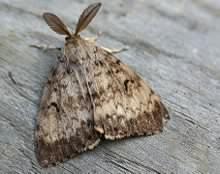Sharing Protocols
This is a central location for BioSAFE website users to find lab protocols published in either Pre-BioSAFE or BioSAFE papers or within one of the project team’s laboratory which we found useful and would like to share them with the scientific community. The protocols will feature mainly the species we are working with in the BioSAFE project. They are made available for you to download however we kindly ask that you reference the paper in the description.
For now we have protocols for Asian Gypsy Moth and Sudden Oak Death. Don’t forget to check back often as we publish new protocols. If you have any questions, please contact us.
Sample prep

AGM TaqMan assay protocol - Part 1 - individual egg masses: This is a step-by-step description of the procedure developed for the analysis of individual gypsy moth egg masses. It can also be used for analysis of other life stages, but the primary focus was egg samples. This suite of assays is not meant to be used for the detection of rare AGM individuals in bulk samples (see Part 2).
Reference publication: Stewart D, Zahiri R, Djoumad A, Freschi L, Lamarche J, Holden D, Cervantes S, Ojeda DI, Potvin A, Nisole A, Béliveau C, Capron A, Kimoto T, Day B, Yueh H, Duff C, Levesque RC, Hamelin RC, Cusson M (2016). A multi-species TaqMan PCR assay for the identification of Asian gypsy moths (Lymantria spp.) and other invasive lymantriines of biosecurity concern to North America. PLoS ONE 11, e0160878.
[Picture from the Canadian Food Inspection Agency]
AGM TaqMan assay protocol - Part 2 - Bulk pheromone trap samples: This is a step-by-step description of the procedure developed for the detection of rare Asian gypsy moths in bulk pheromone trap samples.
Reference publication: This user manual is based on the following publication: Stewart D, Nisole A, Djoumad A, Zahiri R, Lamarche J, Levesque RC, Hamelin RC, Cusson M. 2018. A needle in a haystack: a multigene TaqMan assay for the detection of Asian gypsy moths in bulk pheromone trap samples. Biological Invasions, accepted for publication.
Extractions
To determine if living microorganisms of phytosanitary concern are present in wood after eradication treatment and to evaluate the efficacy of such treatments, the method of choice is to grow microbes in petri dishes for subsequent identification. However, some plant pathogens are difficult or impossible to grow in axenic cultures. A molecular methodology capable of detecting living fungi and fungus-like organisms in situ can provide a solution.
Reference publication: Wong, B., Leal, I., Feau, N., Dale, A., Uzunovic, A. and Hamelin, R. C. 2019. Molecular assays to detect the presence and viability of Phytophthora ramorum and Grosmannia clavigera. bioRxiv 736637; doi: https://doi.org/10.1101/736637
Molecular diagnostics by DNA testing for environmental applications requires a cost-effective and efficient point-of-use DNA test that can obtain accurate results from remote sites in real-time. This requires the development of simple and fast sample processing and DNA extraction, room-temperature stable reagents and a portable instrument. We developed a point-of-use real-time Polymerase Chain Reaction system using a crude buffer-based DNA extraction protocol and lyophilized, pre-made, reactions for on-site applications. Here is the standard operating protocol for assembling the kit described.
Reference publication: This standard operating protocol is based on the following publication: Capron A, Stewart D, Hrywkiw K, Allen K, Feau N, Bilodeau G, et al. (2020) In Situ Processing and Efficient Environmental Detection (iSPEED) of tree pests and pathogens using point-of-use real-time PCR. PLoS ONE 15(4): e0226863. https://doi.org/10.1371/journal.pone.0226863
PCR / RT-PCR
To determine if living microorganisms of phytosanitary concern are present in wood after eradication treatment and to evaluate the efficacy of such treatments, the method of choice is to grow microbes in petri dishes for subsequent identification. However, some plant pathogens are difficult or impossible to grow in axenic cultures. A molecular methodology capable of detecting living fungi and fungus-like organisms in situ can provide a solution.
Reference publication: Wong, B., Leal, I., Feau, N., Dale, A., Uzunovic, A. and Hamelin, R. C. 2019. Molecular assays to detect the presence and viability of Phytophthora ramorum and Grosmannia clavigera. bioRxiv 736637; doi: https://doi.org/10.1101/736637
Molecular diagnostics by DNA testing for environmental applications requires a cost-effective and efficient point-of-use DNA test that can obtain accurate results from remote sites in real-time. This requires the development of simple and fast sample processing and DNA extraction, room-temperature stable reagents and a portable instrument. We developed a point-of-use real-time Polymerase Chain Reaction system using a crude buffer-based DNA extraction protocol and lyophilized, pre-made, reactions for on-site applications. Here is the standard operating protocol for assembling the kit described.
Reference publication: This standard operating protocol is based on the following publication: Capron A, Stewart D, Hrywkiw K, Allen K, Feau N, Bilodeau G, et al. (2020) In Situ Processing and Efficient Environmental Detection (iSPEED) of tree pests and pathogens using point-of-use real-time PCR. PLoS ONE 15(4): e0226863. https://doi.org/10.1371/journal.pone.0226863
Manual for a portable assay to detect Asian Spongy Moth (ASM) from egg mass samples. This system consists of a single triplex reaction (“Triplex 1”) targeting three different mitochondrial marker genes. It will identify moths from the ASM complex (L. dispar asiatica, L. dispar japonica and L. umbrosa).

